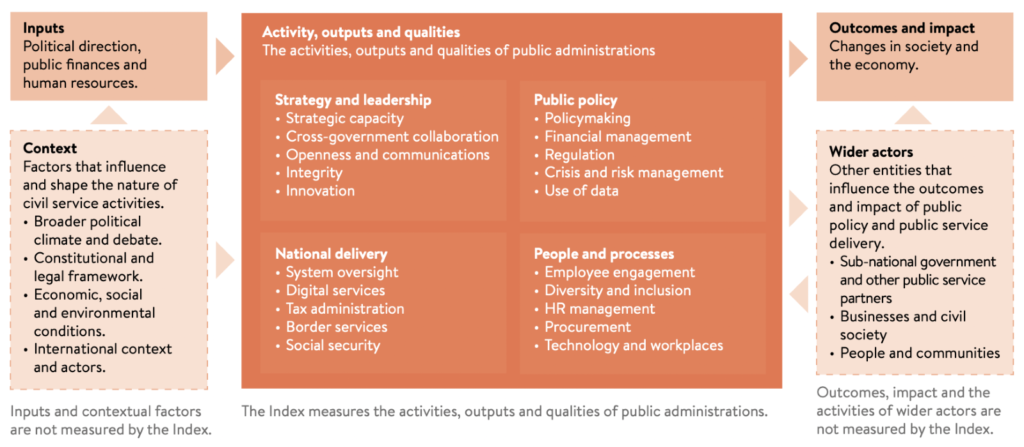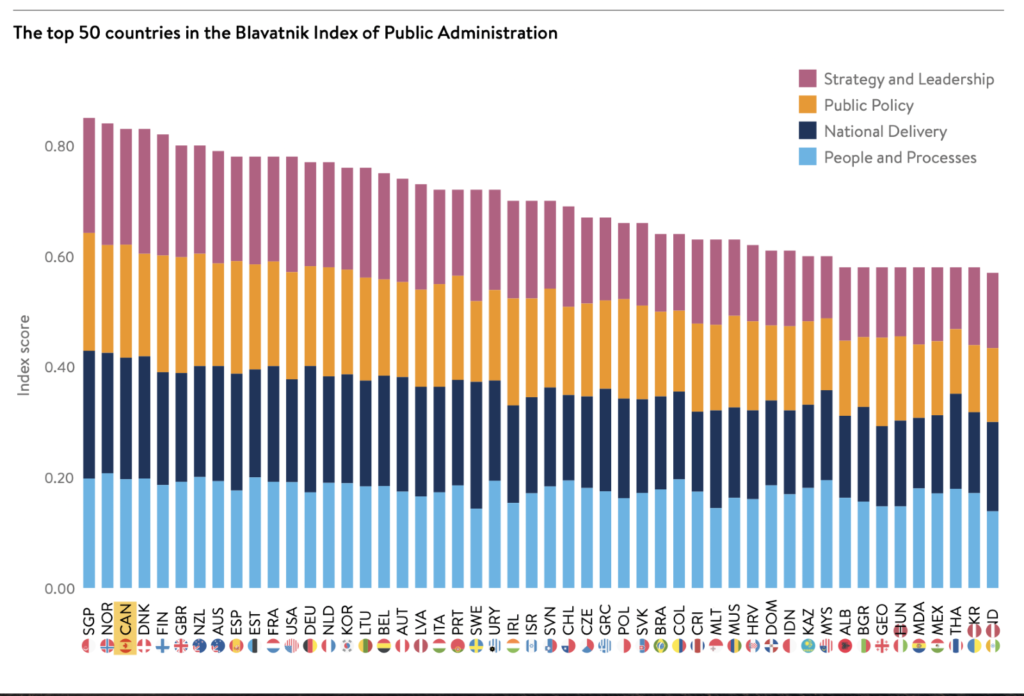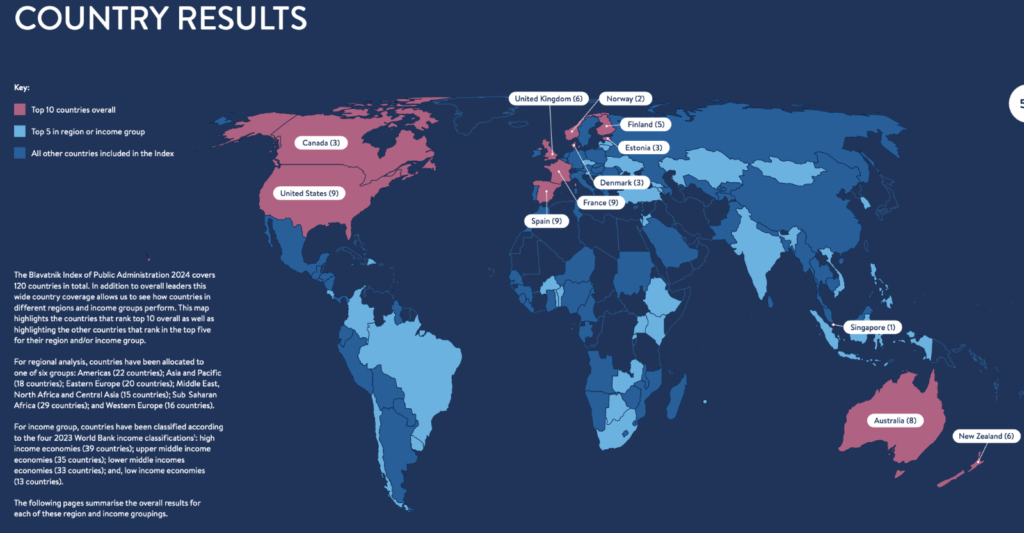How does Canada’s public service compare to the rest of the world?
Not badly, according to a new global scorecard. The 2024 Blavatnik Index of Public Administration from the University of Oxford was calculated across 120 countries based on 82 metrics from 17 data sources. It compared each country’s public administration across four broad “domains”, and 2 “themes”.
Those four domains cover broad areas of public administration activity including;
- Strategy and Leadership – setting of strategic direction, institutional stewardship, the core public service values and behaviours.
- Public Policy – core public administration functions and activities.
- National Delivery – direct public service delivery at the national level and oversight of the wider range of public services delivered by others.
- People and Processes – the realities of working in or for the public administration.
Before reviewing Canada’s rankings, here’s the conceptual framework behind the Inde setting out the 4 domains and each of the 20 themes within them:

Through common assessment, the Index seeks to measurably compare one country’s public administration against others.
How does Canada Rank?
Overall, we’re tied for third. Here’s where Canada ranks across all countries, on a scale of 0.00 to 1.00, where 1.00 represents the highest score possible. Singapore is first and Norway, second. Canada is tied with Denmark for third place with a score of 0.83, just slightly behind the top score of 0.85. Finland rounded out the top 5 counties with an overall score of 0.82 – all very close to each other.

Below is the comparison of the top 50 countries with the four policy domains stacked:

As the figure shows, there is some movement across the four domains and 20 themes. Not every country was first in all domains or all themes. Canada, however, was a consistent fourth across the four domains. The figure below shows Canada’s placement in each of the four domains:








Canada’s Ranking by Theme
Each of the 4 broad domains contains 5 specific themes for a total of 20, meant to cover the main components of activity that governments typically undertake within the domain. Not every theme had sufficient comparable data to measure and assess all countries; these are marked with an asterisk *
Taken together, the themes roll up to the overall scoring and ranking for countries within each domain. Let’s see how Canada performs.
The Strategy and Leadership domain assesses the setting of the strategic direction for a government’s programme of work, the stewardship of public institutions, and the overarching values that guide the behaviours of and approach taken by public officials. It consists of the following five themes:
- strategic capacity – extent to which governments can develop effective policy to ensure that the institutional structure of government remains fit for purpose
- cross-government collaboration*
- openness and communications – extent to which governments consult
and engage with citizens and stakeholders in policy development and the extent to which laws, regulations and government information is publicly available
- integrity – extent to which public officials make decisions and exercise their duties impartially and do not engage in corruption
- innovation – degree to which new ideas, policies, and ways of operating can be freely developed.

Canada ranks highest on “strategic capacity” and lowest on “innovation” within this domain.
The Public Policy domain seeks to assess core public administration functions compatible for any national government. It consists of the following five themes:
- policy making – extent to which governments can develop effective policy.
- financial management*
- regulation – use of impact assessment in the development of regulations and that regulations are enforced properly and efficiently
- crisis and risk management – how well governments prepare for and manage critical risks to the functioning of their country’s society and economy
- use of data – measure the availability and extent of official statistics and other published data (as proxy for capacity of governments to develop policy and deliver public services).

Canada ranks highest on “policy-making” and “regulation” and lowest on “use of data” within this domain.
The National Delivery domain seeks to assess the ability of the national government to oversee the delivery of public services, including those services it delivers itself. It focuses on national level services avoiding inter-jurisdictional service delivery items like health, education, and labour markets. Given this, higher country rankings do not necessarily mean that countries have better policy outcomes, but rather better approaches for overseeing/managing their public services than those they rank above.
It consists of the following five themes:
- system oversight – extent to which the government can achieve its policy objectives through its own means and through leadership and stewardship of wider delivery systems
- digital services – government’s support for digital public services through the strategies and policies that support their development, the technologies that enable them to work effectively, and the end user experience.
- tax administration – the operational quality of a country’s national level tax administration
- border services – operational quality of a country’s national borders, the extent to which legitimate goods/services can be transacted across the border, and the ease with which tourists and business visitors can enter/leave the country.
- social security*

Canada ranks highest on “system oversight” and “border services” and lowest on “tax administration” within this domain.
The People and Processes domain seeks to assess what and how it feels to work in or for a country’s public administration. It consists of the following five themes:
- employee engagement*
- diversity and inclusion – extent to which the public administration workforce reflects the population and society it serves
- HR management – formal practices that govern the recruitment and management of an effective public administration workforce.
- procurement – the operational quality of public procurement practices.
- technology and workplaces – the enabling environment for public employees, the IT systems they use, and the buildings and locations they work in.

Canada ranks highest on “diversity and inclusion” and lowest on “technology and workplaces” within this domain.
Making Sense of the Index
Is the Index useful? Its authors contend so despite the caution that it “is not a definitive assessment of a country’s performance”. They acknowledge there are data gaps and that comparability of data across countries remains a challenge. Still, their aim is “…to foster a data-informed approach to peer learning about the management and reform of public administrations and civil services.”
The Index’s conceptual framework is focused on measuring the activities, outputs, and qualities of the public administrations, rather than measuring outcomes or the broader inputs (political direction, public finances, or human resources) that shape the work and capacity of governments. The underlying logic is that countries with better public administrations can, and will, deliver better outcomes. That same logic recognises that there are a range of other actors, such as regional government, businesses and local communities, who participate in public administration in various forms in countries. These are not captured in the Index.
This makes the Index useful but not determinative. There is still work to be done before it can be practicably useful as a guide for governments to assess public service performance. Lack of internationally comparative data means an overreliance on some proxy information to make up the difference. This will have to be addressed over time. Peer-country comparisons, some of which are set out in the report, are likely a better way forward than a broad-based global index. Nevertheless, directionally, it has merit. And it could spur governments to undertake their own additional data and information gathering to fill in gaps and answer any questions about performance and ranking.
Interestingly, the report stives to consider broader implications of size and scale of public administrations and countries’ performance. Two broad conclusions emerged:
- there is no strong correlation between how well countries did on the Index score with either population size or government expenditure
- countries with better public administrations tend to have better social outcomes.
Takeaways for Canada
Canada’s ranking within the top five countries for public administration performance is the product of its historic professionalism and quality advancement decade over decade. Yet, it is no panacea for what ails the country today or reforms urgently required to our system of public administration. International gratification should not obscure domestic obligation.
What stands out most is consistency. Canada and Singapore are the only countries to be in rank in the top five of each of the four broad domains. Nevertheless, we are not the top performer in any of the four domains, ranking 4th overall, as we have seen. Our best overall domain ranking is “Strategy and Leadership”; our worst is “People and Processes”, based on adding up the scores for each theme.
Across individual themes measured, Canada’s highest ranking is 2nd for “strategic capacity”; our lowest is 36th for “technology and workplaces”. Our best rankings are in the following:
- strategic capacity – 2nd
- system oversight – 3rd
- border services – 3rd
- trust and integrity – 4th
Canada’s data coverage rates an overall grade of B.
You can read the whole report for yourself here: https://index.bsg.ox.ac.uk


